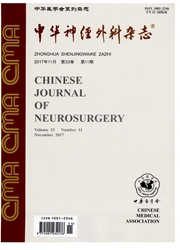

 中文摘要:
中文摘要:
目的分析运动障碍性疾病立体定向手术中脑出血危险因素,以降低脑出血并发症。方法对689例运动障碍性疾病进行了立体定向脑深部刺激术(DBS)和毁损术,共有853个靶点进行了手术治疗,其中丘脑底核(STN)刺激术188个,丘脑腹中间核(Vim)刺激术5个,苍白球内侧部DBS2个,苍白球腹后部毁损术(PVP)478个,Vim毁损术180个。结果术后无症状性脑出血14例,症状性脑出血10例。有高血压病史患者脑出血发生率明显高于无高血压病史患者。在微电极记录2-4条针道的手术靶点中,脑出血发生率显著高于微电极记录1条针道的脑出血发生率。DBS、PVP及Vim毁损术靶点脑出血发生率分别为0.5%、3.6%及3.3%,前者发生率明显低于后两者。结论高血压病史是帕金森病立体定向手术并发脑出血的危险因素,微电极记录针道数与脑出血发生率成明显正相关,脑深部刺激术是较毁损术更安全的外科治疗方法。
 英文摘要:
英文摘要:
Objective To analyze the risk factors of intracranial hemorrhage in deep brain stimulation(DBS) and ablation procedures in a large series of patients with movement disorders in order to reduce the incidence of hemorrhage. Methods 689 patients treated with DBS and ablation procedures were enrolled in this study (DBS in 113cases, ablation in 576 cases and DBS after prior unilateral ablation procedure in 11 cases). In 853 target procedures, DBS was employed in 195 targets( 188 subthalamic nucleus targets, 5 ventral intermediate targets and 2 internal globus pallidus targets), the ablation procedure was employed in 658 targets (478 internal globus pallidus targets, 180 ventral intermediate targets). Results There were 14 asymptomatic and 10 symptomatic intracranial hematomas. There was a statistically significant relationship between the risk of symptomatic hematoma and hypertension. The incidence of hematoma in 2 - 4 microelectrode recording penetrations was 6. 9% , whereas 2. 2% in 1 microelectrode recording penetration. There was only one asymptomatic hematoma in 195 DBS targets. Conclusion The number of microelectrode passes used to determine target location is correlated with the risk of hemorrhage. Ablation orocedure carries a higher risk of hemorrhage than that of DBS.
 同期刊论文项目
同期刊论文项目
 同项目期刊论文
同项目期刊论文
 期刊信息
期刊信息
